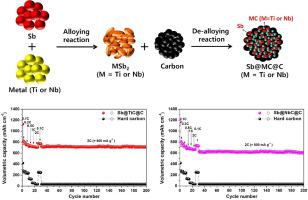Chemical Engineering Journal ( IF 13.3 ) Pub Date : 2020-10-16 , DOI: 10.1016/j.cej.2020.127380 Dong-Keun Yu , Cheol-Min Park

|
To achieve high-performance Sb-based anodes for Na-ion battery (NIB), various approaches for obtaining amorphous C-containing Sb composite (Sb@C), Sb-based intermetallic compounds (TiSb2 and NbSb2), and Na-inactive metal carbide and amorphous C-containing Sb composites (Sb@TiC@C and Sb@NbC@C) have been introduced. First, Sb@C was prepared using a simple solid-state ball-milling, and then its potential as a NIB anode material was investigated. The electrochemical phase change mechanism of Sb during the sodiation/desodiation of Sb@C was investigated using various ex situ analytical techniques. Sb was found to sequentially transform into NaSb and Na3Sb during sodiation and NaSb and Sb during desodiation. Second, as another trial to further improve the electrochemical performance of Sb, Sb-based intermetallic compounds of TiSb2 and NbSb2 were synthesized by alloying reaction via a simple solid state heat-treatment and their potential as NIB anode materials was investigated. Lastly, the Sb@TiC@C and Sb@NbC@C nanocomposites comprising tiny (~3–5 nm) Sb nanocrystallites and Na-inactive metal carbide (TiC/NbC) matrix embedded in buffering amorphous C were synthesized by alloying and dealloying reaction. The Sb@TiC@C and Sb@NbC@C demonstrated highly reversible, stable capacity (Sb@TiC@C: 746 mAh cm−3, Sb/NbC/C: 726 mAh cm−3 after 100 cycles) and fast rate capability with exceptional capacity retentions after 400 cycles (Sb@TiC@C: ~710 mAh cm−3 at 2 C rate, Sb@NbC@C: ~680 mAh cm−3 at 2 C rate). Therefore, the Sb-based nanocomposites synthesized by alloying and dealloying are considered to be possible new anode materials for use in high-performance NIBs.
中文翻译:

锑基金属间化合物和纳米复合材料,可作为稳定,快速的钠离子电池阳极
为了获得用于Na离子电池(NIB)的高性能Sb基阳极,可以采用各种方法来获得非晶态的含C的Sb复合材料(Sb @ C),Sb基金属间化合物(TiSb 2和NbSb 2)和Na-引入了惰性金属碳化物和无定形含碳Sb复合材料(Sb @ TiC @ C和Sb @ NbC @ C)。首先,使用简单的固态球磨制备Sb @ C,然后研究其作为NIB阳极材料的潜力。使用各种非原位分析技术研究了Sb @ C在Sb @ C的消沉过程中的电化学相变机理。发现Sb依次转化为NaSb和Na 3固态化过程中的Sb以及固态化过程中的NaSb和Sb。其次,作为进一步改善Sb电化学性能的另一项试验,通过简单的固态热处理通过合金化反应合成了基于Sb的TiSb 2和NbSb 2金属间化合物,并研究了它们作为NIB负极材料的潜力。最后,通过合金化和脱合金反应合成了Sb @ TiC @ C和Sb @ NbC @ C纳米复合材料,该复合材料包含微小的(〜3–5 nm)Sb纳米微晶和嵌入非晶态C中的Na惰性金属碳化物(TiC / NbC)基体。 。Sb @ TiC @ C和Sb @ NbC @ C表现出高度可逆的,稳定的容量(Sb @ TiC @ C:746 mAh cm -3,Sb / NbC / C:726 mAh cm -3100次循环后)和快速速率能力,以及400次循环后具有出色的容量保持能力(Sb @ TiC @ C:2 C速率下约为710 mAh cm -3,Sb @ NbC @ C:2 C速率下约为680 mAh cm -3) 。因此,通过合金化和脱合金合成的Sb基纳米复合材料被认为是用于高性能NIB的新型阳极材料。











































 京公网安备 11010802027423号
京公网安备 11010802027423号